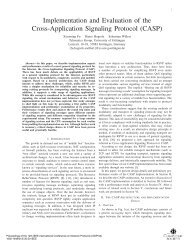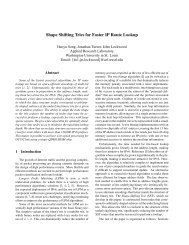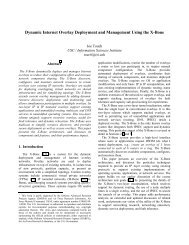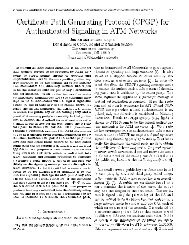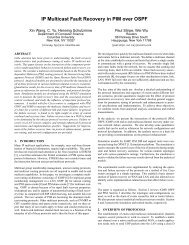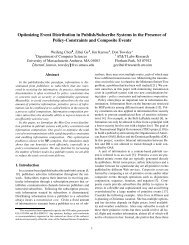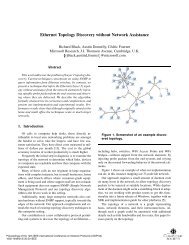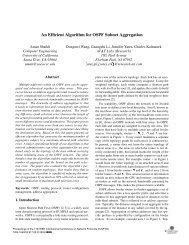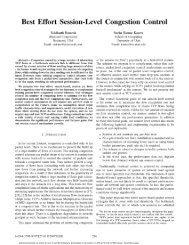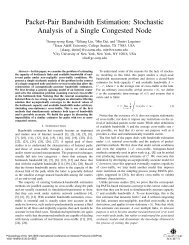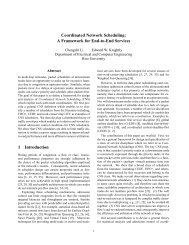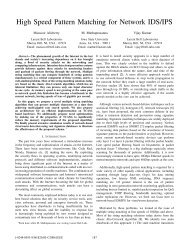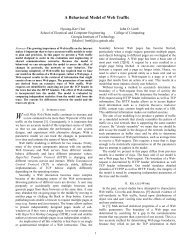Differential congestion notification: taming the elephants ... - ICNP
Differential congestion notification: taming the elephants ... - ICNP
Differential congestion notification: taming the elephants ... - ICNP
Create successful ePaper yourself
Turn your PDF publications into a flip-book with our unique Google optimized e-Paper software.
<strong>Differential</strong> Congestion Notification: Taming <strong>the</strong> Elephants<br />
Long Le Jay Aikat Kevin Jeffay F. Donelson Smith<br />
Department of Computer Science<br />
University of North Carolina at Chapel Hill<br />
http://www.cs.unc.edu/Research/dirt<br />
Abstract — Active queue management (AQM) in routers has<br />
been proposed as a solution to some of <strong>the</strong> scalability issues associated<br />
with TCP’s pure end-to-end approach to <strong>congestion</strong> control.<br />
A recent study of AQM demonstrated its effectiveness in reducing<br />
<strong>the</strong> response times of web request/response exchanges as<br />
well as increasing link throughput and reducing loss rates [10].<br />
However, use of <strong>the</strong> ECN (explicit <strong>congestion</strong> <strong>notification</strong>) signaling<br />
protocol was required to outperform drop-tail queuing.<br />
Since ECN is not currently widely deployed on end-systems, we<br />
investigate an alternative to ECN, namely applying AQM differentially<br />
to flows based on a heuristic classification of <strong>the</strong> flow’s<br />
transmission rate. Our approach, called differential <strong>congestion</strong><br />
<strong>notification</strong> (DCN), distinguishes between “small” flows and<br />
“large” high-bandwidth flows and only provides <strong>congestion</strong> <strong>notification</strong><br />
to large high-bandwidth flows. We compare DCN to o<strong>the</strong>r<br />
prominent AQM schemes and demonstrate that for web and general<br />
TCP traffic, DCN outperforms all <strong>the</strong> o<strong>the</strong>r AQM designs,<br />
including those previously designed to differentiate between flows<br />
based on <strong>the</strong>ir size and rate.<br />
1. Introduction<br />
Congestion control on <strong>the</strong> Internet has historically been<br />
performed end-to-end with end-systems assuming <strong>the</strong> responsibility<br />
for detecting <strong>congestion</strong> and reacting to it appropriately.<br />
Currently, TCP implementations detect instances<br />
of packet loss, interpret <strong>the</strong>se events as indicators of<br />
<strong>congestion</strong>, and reduce <strong>the</strong> rate at which <strong>the</strong>y are transmitting<br />
data by reducing <strong>the</strong> connection’s window size. This<br />
<strong>congestion</strong> reaction (combined with a linear probing <strong>congestion</strong><br />
avoidance mechanism) successfully eliminated <strong>the</strong><br />
occurrence of <strong>congestion</strong> collapse events on <strong>the</strong> Internet<br />
and has enabled <strong>the</strong> growth of <strong>the</strong> Internet to its current<br />
size.<br />
However, despite this success, concerns have been raised<br />
about <strong>the</strong> future of pure end-to-end approaches to <strong>congestion</strong><br />
control [1, 5]. In response to <strong>the</strong>se concerns, routerbased<br />
<strong>congestion</strong> control schemes known as active queue<br />
management (AQM) have been developed and proposed for<br />
deployment on <strong>the</strong> Internet [1]. With AQM, it is now possible<br />
for end-systems to receive a signal of incipient <strong>congestion</strong><br />
prior to <strong>the</strong> actual occurrence of <strong>congestion</strong>. The signal<br />
can be implicit, realized by a router dropping a packet from<br />
a connection even though resources exist to enqueue and<br />
forward <strong>the</strong> packet, or <strong>the</strong> signal can be explicit, realized by<br />
a router setting an explicit <strong>congestion</strong> <strong>notification</strong> (ECN) bit<br />
in <strong>the</strong> packet’s header and forwarding <strong>the</strong> packet.<br />
In a previous study of <strong>the</strong> effects of prominent AQM designs<br />
on web performance, we argued that ECN was required<br />
in order to realize <strong>the</strong> promise of AQM [10]. This<br />
was a positive result that showed a tangible benefit to both<br />
users and service providers to deploying AQM with ECN.<br />
When compared to drop-tail routers, <strong>the</strong> deployment of<br />
particular AQM schemes with ECN (and with ECN support<br />
in end-system protocol stacks) allowed users to experience<br />
significantly reduced response times for web request/response<br />
exchanges, and allowed service providers to<br />
realize higher link utilization and lower loss rates. Without<br />
ECN, certain AQM schemes could realize modest performance<br />
improvements over simple drop-tail queue management,<br />
but <strong>the</strong> gains were small compared to those achievable<br />
with ECN.<br />
The positive ECN results, however, beg <strong>the</strong> question of<br />
whe<strong>the</strong>r or not all AQM inherently requires ECN in order to<br />
be effective, or if it simply is <strong>the</strong> case that only existing<br />
AQM designs require ECN in order to be effective. This is<br />
a significant issue because ECN deployment requires <strong>the</strong><br />
participation of both routers and end-systems and hence<br />
raises a number of issues including <strong>the</strong> cost and complexity<br />
of implementing and deploying ECN, <strong>the</strong> incremental deployability<br />
of ECN, and <strong>the</strong> (largely unstudied) issue of<br />
dealing with malicious end-systems that advertise ECN<br />
support but in fact ignore ECN signals or simply have not<br />
been configured appropriately. O<strong>the</strong>r deployment issues<br />
include <strong>the</strong> fact that many firewalls and network address<br />
translators intentionally or unintentionally drop all ECN<br />
packets or clear ECN bits. In a study of TCP behavior, Padhye<br />
and Floyd found that less than 10% of <strong>the</strong> 24,030 web<br />
servers tested had ECN enabled, of which less than 1% had<br />
a compliant implementation of ECN [14]. More recent results<br />
(August 2003) showed that only 1.1% of 441 web<br />
servers tested had correctly deployed ECN [15]. This<br />
clearly points to obvious difficulties in deploying and properly<br />
using ECN on <strong>the</strong> end-systems. Thus, AQM could be<br />
significantly more appealing if ECN were not required for<br />
effective operation.<br />
In this paper, we present an AQM design that signals <strong>congestion</strong><br />
based on <strong>the</strong> size and rate of <strong>the</strong> flow and does not<br />
require ECN for good performance. Our approach is to differentially<br />
signal <strong>congestion</strong> to flows (through <strong>the</strong> dropping<br />
of packets) based upon a heuristic classification of <strong>the</strong><br />
Proceedings of <strong>the</strong> 12th IEEE International Conference on Network Protocols (<strong>ICNP</strong>’04)<br />
1092-1648/04 $ 20.00 IEEE
length and rate of <strong>the</strong> flow. We classify traffic into “mice,”<br />
short connections that dominate on many Internet links<br />
(more than 84% of all flows in some cases [21]), and “<strong>elephants</strong>,”<br />
long connections that, while relatively rare, account<br />
for <strong>the</strong> majority of bytes transferred on most links<br />
(more than 80% of all bytes [21]). Our AQM design attempts<br />
to notify only high-bandwidth “<strong>elephants</strong>” of <strong>congestion</strong><br />
while allowing “slower” (and typically shorter)<br />
connections to remain unaware of incipient <strong>congestion</strong>. The<br />
motivation for this approach, borne out by our analysis of<br />
AQM schemes, is that providing early <strong>congestion</strong> <strong>notification</strong>s<br />
to mice only hurts <strong>the</strong>ir performance by forcing <strong>the</strong>se<br />
short TCP connections to simply wait longer to transmit<br />
<strong>the</strong>ir last few segments. These short flows are often too<br />
short to have a meaningful transmission rate and are so<br />
short that slowing <strong>the</strong>m down does not significantly reduce<br />
<strong>congestion</strong>. In contrast, providing early <strong>congestion</strong> <strong>notification</strong><br />
to <strong>elephants</strong> can lead to abatement of <strong>congestion</strong> and<br />
more efficient use of <strong>the</strong> network. Our form of differential<br />
<strong>congestion</strong> <strong>notification</strong>, called DCN, significantly improves<br />
<strong>the</strong> performance of <strong>the</strong> vast majority of TCP transfers and<br />
provides response times, link utilizations, and loss ratios<br />
that are better than those of existing AQM schemes including<br />
those that also attempt to differentiate between flows<br />
based on <strong>the</strong>ir size and rate.<br />
The remainder of <strong>the</strong> paper makes <strong>the</strong> case for differential<br />
<strong>congestion</strong> <strong>notification</strong> based on classification of flow-rate.<br />
Section 2 discusses previous related work in AQM schemes<br />
in general and in differential AQM specifically. Section 3<br />
presents our DCN scheme. Section 4 explains our experimental<br />
evaluation methodology and Section 5 presents <strong>the</strong><br />
results of a performance study of DCN and several prominent<br />
AQM schemes from <strong>the</strong> literature. The results are discussed<br />
in Section 6.<br />
2. Background and Related Work<br />
Several AQM designs have attempted to achieve fairness<br />
among flows or to control high-bandwidth flows. Here we<br />
give a description of <strong>the</strong> AQM designs most related to ours.<br />
The Flow Random Early Drop (FRED) algorithm protects<br />
adaptive flows from unresponsive and greedy flows by implementing<br />
per-flow queueing limits [11]. The algorithm<br />
maintains state for each flow that currently has packets<br />
queued in <strong>the</strong> router. Each flow is allowed to have up to<br />
min q but never more than max q packets in <strong>the</strong> queue. Packets<br />
of flows that have more than min q but less than max q<br />
packets in <strong>the</strong> queue are probabilistically dropped. When<br />
<strong>the</strong> number of flows is large and a high-bandwidth flow<br />
consumes only a small fraction of <strong>the</strong> link capacity, FRED<br />
maintains a large queue. However, a large queue results in<br />
high delay. Fur<strong>the</strong>rmore, <strong>the</strong> algorithm becomes less efficient<br />
with a large queue since <strong>the</strong> search time for flow state<br />
is proportional to queue length.<br />
The Stabilized Random Early Drop (SRED) algorithm controls<br />
<strong>the</strong> queue length around a queue threshold independent<br />
of <strong>the</strong> number of active connections [13]. The algorithm<br />
keeps <strong>the</strong> header of recent packet arrivals in a “zombie list.”<br />
When a packet arrives, it is compared with a randomly chosen<br />
packet from <strong>the</strong> zombie list. If <strong>the</strong> two packets are of<br />
<strong>the</strong> same flow, a “hit” is declared. O<strong>the</strong>rwise, <strong>the</strong> packet<br />
header in <strong>the</strong> zombie list is probabilistically replaced by <strong>the</strong><br />
header of <strong>the</strong> new packet. The number of active connections<br />
is estimated as <strong>the</strong> reciprocal of <strong>the</strong> average number of hits<br />
in a given interval (a large number of active connections<br />
results in a low probability of hits and vice versa). The drop<br />
probability of a packet is a function of <strong>the</strong> instantaneous<br />
queue length and <strong>the</strong> estimated number of active connections.<br />
Hits are also used to identify high-bandwidth flows.<br />
Packets of high-bandwidth flows are dropped with a higher<br />
probability than o<strong>the</strong>r packets.<br />
The CHOKe algorithm heuristically detects and discriminates<br />
against high-bandwidth flows without maintaining per<br />
flow state [17]. The algorithm is based on <strong>the</strong> assumption<br />
that a high-bandwidth flow is likely to occupy a large<br />
amount of buffer space in <strong>the</strong> router. When a new packet<br />
arrives, CHOKe picks a random packet in <strong>the</strong> queue and<br />
compares that packet’s header with <strong>the</strong> new packet’s<br />
header. If both packets belong to <strong>the</strong> same flow, both are<br />
dropped, o<strong>the</strong>rwise, <strong>the</strong> new packet is enqueued. As with<br />
FRED, CHOKe is not likely to work well on a high-speed<br />
link and in <strong>the</strong> presence of a large aggregate of flows.<br />
The Stochastic Fair BLUE (SFB) algorithm detects and<br />
rate-limits unresponsive flows by using accounting bins that<br />
are organized hierarchically [4]. The bins are indexed by<br />
hash keys computed from a packet’s IP addresses and port<br />
numbers and used to keep track of queue occupancy statistics<br />
of packets belonging to <strong>the</strong> bin. High-bandwidth flows<br />
can be easily identified because <strong>the</strong>ir bins’ occupancy is<br />
always high. These high-bandwidth flows are <strong>the</strong>n ratelimited.<br />
SFB works well when <strong>the</strong> number of highbandwidth<br />
flows is small. When <strong>the</strong> number of highbandwidth<br />
flows increases, more bins become occupied and<br />
low bandwidth flows that hash to <strong>the</strong>se bins are incorrectly<br />
identified as high-bandwidth and penalized.<br />
The Approximate Fairness through <strong>Differential</strong> Dropping<br />
(AFD) algorithm approximates fair bandwidth allocation by<br />
using a history of recent packet arrivals to estimate a flow’s<br />
transmission rate [16]. AFD uses a control <strong>the</strong>oretic algorithm<br />
borrowed from PI [7] to estimate <strong>the</strong> “fair share” of<br />
bandwidth that a flow is allowed to send. Packets of a flow<br />
are marked or dropped with a probability that is a function<br />
of <strong>the</strong> flow’s estimated sending rate. The algorithm uses a<br />
shadow buffer to store recent packet headers and uses <strong>the</strong>se<br />
to estimate a flow’s rate. The estimated rate of a flow is<br />
proportional to <strong>the</strong> number of that flow’s headers in <strong>the</strong><br />
shadow buffer. When a packet arrives, its header is copied<br />
to <strong>the</strong> shadow buffer with probability 1/s, where s is <strong>the</strong><br />
Proceedings of <strong>the</strong> 12th IEEE International Conference on Network Protocols (<strong>ICNP</strong>’04)<br />
1092-1648/04 $ 20.00 IEEE
sampling interval, and ano<strong>the</strong>r header is removed randomly<br />
from <strong>the</strong> shadow buffer. Note that while sampling reduces<br />
implementation overhead, it also reduces <strong>the</strong> accuracy in<br />
estimating flows’ sending rate. This problem can be severe<br />
when most flows only send a few packets per RTT.<br />
The RED with Preferential Dropping (RED-PD) algorithm<br />
provides protection for responsive flows by keeping state<br />
for just <strong>the</strong> high-bandwidth flows and preferentially dropping<br />
packets of <strong>the</strong>se flows [12]. RED-PD uses <strong>the</strong> history<br />
of recent packet drops to identify and monitor highbandwidth<br />
flows. The algorithm is based on <strong>the</strong> assumption<br />
that high-bandwidth flows also have a high number of<br />
packet drops in <strong>the</strong> drop history. Packets of a highbandwidth<br />
flow are dropped with a higher probability than<br />
o<strong>the</strong>r packets. After being identified as high-bandwidth, a<br />
flow is monitored until it does not experience any packet<br />
drop in a certain time period. The absence of packet drops<br />
of a high-bandwidth flow in <strong>the</strong> drop history indicates that<br />
<strong>the</strong> flow has likely reduced its sending rate. In this case, <strong>the</strong><br />
flow is deleted from <strong>the</strong> list of monitored flows.<br />
The RIO-PS scheme (Red with In and Out with Preferential<br />
treatment to Short flows) gives preferential treatment to<br />
short flows at bottleneck links [6]. With preferential treatment,<br />
short flows experience a lower drop-rate than long<br />
flows and can thus avoid timeouts. In RIO-PS, edge routers<br />
maintain per-flow state for flows entering <strong>the</strong> network. The<br />
first few packets of a flow are marked as “short” or “in.”<br />
Subsequent packets of that flow are marked as “long” or<br />
“out.” Core routers use <strong>the</strong> standard RIO algorithm [2] and<br />
drop long or out packets with a higher probability than short<br />
or in packets.<br />
Our DCN algorithm, described next, is an amalgam of existing<br />
AQM mechanisms. Like AFD it uses a control <strong>the</strong>oretic<br />
algorithm for selecting packets to drop and like RED-<br />
PD it maintains state for only <strong>the</strong> suspected high-bandwidth<br />
flows. However, we show empirically that our particular<br />
choice and construction of mechanisms results in better<br />
application and network performance than is possible with<br />
existing differential and non-differential AQM designs.<br />
3. The DCN Algorithm<br />
The design of DCN is based on <strong>the</strong> observation that on<br />
many networks, a small number of flows produce a large<br />
percentage of <strong>the</strong> traffic. For example, for <strong>the</strong> web traffic<br />
we have used to evaluate AQM designs, Figure 1 shows <strong>the</strong><br />
cumulative distribution function (CDF) of <strong>the</strong> empirical<br />
distribution of HTTP response sizes [18]. Figure 2 shows a<br />
CDF of <strong>the</strong> percentage of total bytes transferred in an hourlong<br />
experiment as a function of HTTP response size. Toge<strong>the</strong>r,<br />
<strong>the</strong>se figures show that while approximately 90% of<br />
web responses are 10,000 bytes or less, <strong>the</strong>se responses<br />
account for less than 25% of <strong>the</strong> bytes transferred during an<br />
experiment. Moreover, responses greater than 1 megabyte<br />
Cumulative probability<br />
Percentage of bytes transferred<br />
1<br />
0.9<br />
0.8<br />
0.7<br />
0.6<br />
0.5<br />
0.4<br />
0.3<br />
0.2<br />
0.1<br />
Generated response sizes<br />
0<br />
10 100 1000 10000 100000 1e+06 1e+07 1e+08 1e+09<br />
Response size (bytes)<br />
1<br />
0.9<br />
0.8<br />
0.7<br />
0.6<br />
0.5<br />
0.4<br />
0.3<br />
0.2<br />
0.1<br />
Figure 1: CDF of generated response sizes.<br />
0<br />
100 1000 10000 100000 1e+06 1e+07 1e+08 1e+09<br />
Response size (bytes)<br />
Figure 2: CDF of percentage of total bytes transferred as a function<br />
of response sizes.<br />
make up less than 1% of all responses, but account for 25%<br />
of <strong>the</strong> total bytes.<br />
These data suggest that providing early <strong>congestion</strong> <strong>notification</strong><br />
to flows carrying responses consisting of a few TCP<br />
segments (e.g., flows of 2,000-3,000 bytes, approximately<br />
70% of all flows), would have little effect on <strong>congestion</strong>.<br />
This is because <strong>the</strong>se flows comprise only 6-8% of <strong>the</strong> total<br />
bytes and because <strong>the</strong>se flows are too short to have a transmission<br />
rate that is adaptable. By <strong>the</strong> time <strong>the</strong>y receive a<br />
<strong>congestion</strong> <strong>notification</strong> signal <strong>the</strong>y have ei<strong>the</strong>r already<br />
completed or have only one segment remaining to be sent.<br />
Fur<strong>the</strong>rmore, since short flows have a small <strong>congestion</strong><br />
window, <strong>the</strong>y have to resort to timeouts when experiencing<br />
a packet loss. Thus giving <strong>the</strong>se flows a <strong>congestion</strong> signal<br />
does not significantly reduce <strong>congestion</strong> and can only hurt<br />
<strong>the</strong> flows’ performance by delaying <strong>the</strong>ir completion. In<br />
contrast, high-bandwidth flows carrying large responses are<br />
capable of reducing <strong>the</strong>ir transmission rate and hence can<br />
have an impact on <strong>congestion</strong>. Unlike short flows, highbandwidth<br />
flows do not have to resort to timeouts and instead<br />
can use TCP mechanisms for fast retransmission and<br />
fast recovery to recover from <strong>the</strong>ir packet losses. Our approach<br />
will also police high-bandwidth non-TCP or non-<br />
Proceedings of <strong>the</strong> 12th IEEE International Conference on Network Protocols (<strong>ICNP</strong>’04)<br />
1092-1648/04 $ 20.00 IEEE
compliant TCP flows that do not reduce <strong>the</strong>ir transmission<br />
rate when <strong>congestion</strong> occurs.<br />
Our observation about traffic characteristics is also confirmed<br />
by o<strong>the</strong>r studies of Internet traffic. For example,<br />
Zhang et al. found that small flows (100KB or less) accounted<br />
for at least 84% of all flows, but carried less than<br />
15% of all bytes [21]. They also found that large flows accounted<br />
for a small fraction of <strong>the</strong> number of flows, but<br />
carried most of <strong>the</strong> bytes. Moreover, <strong>the</strong> flows that are<br />
“large” and “fast” (i.e., high-bandwidth, greater than<br />
10KB/sec) account for less than 10% of all flows, but carrying<br />
more than 80% of all <strong>the</strong> bytes.<br />
The <strong>Differential</strong> Congestion Notification (DCN) scheme is<br />
based on identifying <strong>the</strong>se “large” and “fast” flows, and<br />
providing <strong>congestion</strong> <strong>notification</strong> to only <strong>the</strong>m. While <strong>the</strong><br />
idea is simple, <strong>the</strong> challenge is to design an algorithm with<br />
minimal state requirements to identify <strong>the</strong> few long-lived,<br />
high-bandwidth flows from a large aggregate of flows and<br />
provide <strong>the</strong>m with a <strong>congestion</strong> signal when appropriate.<br />
An important dimension of this problem is that of all <strong>the</strong><br />
flows carrying large responses, we most want to signal<br />
flows that are also transmitting at a high-rate. These are <strong>the</strong><br />
flows that are consuming <strong>the</strong> most bandwidth and hence<br />
will produce <strong>the</strong> greatest effect when <strong>the</strong>y reduce <strong>the</strong>ir rate.<br />
Additionally, we must ensure that flows receiving negative<br />
differential treatment are not subject to undue starvation.<br />
Our DCN AQM design has two main components: identification<br />
of high-bandwidth flows and a decision procedure<br />
for determining when early <strong>congestion</strong> <strong>notification</strong> is in<br />
order.<br />
3.1 Identifying High-bandwidth Flows<br />
Our approach to identifying high-bandwidth, long-lived<br />
flows is based on <strong>the</strong> idea that packets of high-bandwidth<br />
flows are closely paced (i.e., <strong>the</strong>ir interarrival times are<br />
short) [3]. DCN tracks <strong>the</strong> number of packets that have<br />
been recently seen from each flow. If this count exceeds a<br />
threshold, <strong>the</strong> flow is considered to be a “long-lived and<br />
high-bandwidth” flow. The flow’s rate is <strong>the</strong>n monitored<br />
and its packets are eligible for dropping. As long as a flow<br />
remains classified as high-bandwidth, it remains eligible for<br />
dropping. If a flow reduces its transmission rate, it is removed<br />
from <strong>the</strong> list of monitored flows and is no longer<br />
eligible for dropping.<br />
DCN uses two hash tables for classifying flows: HB (“high<br />
bandwidth”) and SB (“scoreboard”). The HB table tracks<br />
flows that are considered high-bandwidth and stores each<br />
flow’s flow ID (IP addressing 5-tuple) and <strong>the</strong> count of <strong>the</strong><br />
number of forwarded packets. The SB table tracks a fixed<br />
number of flows not stored in HB. For <strong>the</strong>se flows SB<br />
stores <strong>the</strong>ir flow ID and “recent” forwarded packet count.<br />
When a packet arrives at a DCN router, <strong>the</strong> HB table is<br />
checked to see if this packet belongs to a high-bandwidth<br />
flow. If <strong>the</strong> packet’s flow is found in HB, <strong>the</strong>n it is handled<br />
yes<br />
Decrease<br />
pktcount by p ref<br />
(Enqueue if<br />
not dropped)<br />
yes<br />
Mark or drop<br />
probabilistically<br />
Has T dec elapsed<br />
since last decrease<br />
yes<br />
no<br />
Copy flow entry<br />
to HB<br />
yes<br />
Increment pktcount<br />
pktcount ≥ 4<br />
Is Flow ID<br />
in HB<br />
Arriving packet<br />
Last update less<br />
than clearing<br />
interval ago<br />
Enqueue<br />
as described below. If <strong>the</strong> packet’s flow ID is not in HB,<br />
<strong>the</strong>n <strong>the</strong> packet is enqueued and its flow is tested to see if it<br />
should be entered into HB. The SB table is searched for <strong>the</strong><br />
flow’s ID. If <strong>the</strong> flow ID is not present, it is added to SB. 1 If<br />
<strong>the</strong> flow ID is present in SB, <strong>the</strong> flow’s packet count is incremented.<br />
A flow is classified as long-lived and high-bandwidth if <strong>the</strong><br />
number of packets from <strong>the</strong> flow arriving within a “clearing<br />
interval,” exceeds a threshold. Once <strong>the</strong> flow’s packet count<br />
in SB has been incremented, if <strong>the</strong> count exceeds <strong>the</strong><br />
threshold, <strong>the</strong> flow’s entry in SB is added to HB. 2 If no<br />
packets have been received for <strong>the</strong> flow within a clearing<br />
interval, <strong>the</strong> flow’s packet count is reset to 0.<br />
A high-level flow chart of <strong>the</strong> DCN algorithm is given in<br />
Figure 3. All operations on <strong>the</strong> SB table are performed in<br />
O(1) time. Since <strong>the</strong> number of flows identified as highbandwidth<br />
is small (e.g., ~2000 for traffic generated during<br />
experiments reported herein), hash collisions in HB are rare<br />
for a table size of a few thousand entries. Thus, operations<br />
on <strong>the</strong> HB table are also usually executed in O(1) time.<br />
3.2 Early Congestion Notification<br />
Packets from a high-bandwidth flow are dropped with a<br />
probability 1 – p ref / pktcount, where pktcount is <strong>the</strong> number<br />
of packets from that flow that have arrived at <strong>the</strong> router<br />
within a period of T dec , and p ref is <strong>the</strong> current “fair share” of<br />
a flow on a congested link. When <strong>congestion</strong> is suspected in<br />
<strong>the</strong> router we target high-bandwidth flows for dropping in<br />
proportion to <strong>the</strong>ir deviation from <strong>the</strong>ir fair share (p ref packets<br />
within an interval T dec ) [16, 19].<br />
1 If a flow ID hashes to an entry in SB for ano<strong>the</strong>r flow, <strong>the</strong>n <strong>the</strong><br />
new flow overwrites <strong>the</strong> entry for <strong>the</strong> previous flow. This ensures<br />
that all SB operations can be performed in constant time. Thus, SB<br />
stores <strong>the</strong> packet counts for all currently active non-highbandwidth<br />
flows, modulo hash function collisions on flow IDs.<br />
2<br />
If a collision occurs in HB when trying to insert <strong>the</strong> new flow,<br />
<strong>the</strong>n a hash chain is used to locate a free table entry.<br />
yes<br />
no<br />
Is Flow ID<br />
in SB<br />
no<br />
Reset pktcount<br />
Figure 3: High-level DCN flowchart.<br />
no<br />
Overwrite <strong>the</strong><br />
existing flow entry<br />
Proceedings of <strong>the</strong> 12th IEEE International Conference on Network Protocols (<strong>ICNP</strong>’04)<br />
1092-1648/04 $ 20.00 IEEE
DCN uses a simple control <strong>the</strong>oretic algorithm based on <strong>the</strong><br />
well-known proportional integral controller to compute p ref .<br />
The instantaneous length of <strong>the</strong> queue in <strong>the</strong> router is periodically<br />
sampled with period T update . A flow’s fair share of<br />
<strong>the</strong> queue at <strong>the</strong> k th sampling period is given by:<br />
p ref (kT update ) = p ref ((k–1)T update ) + a (q(kT update ) – q ref ) –<br />
b (q((k–1)T update ) – q ref )<br />
where a and b, a < b, are control coefficients (constants)<br />
that depend on <strong>the</strong> average number of flows and <strong>the</strong> average<br />
RTT of flows (see [7] for a discussion), q() is <strong>the</strong> length of<br />
<strong>the</strong> queue at a given time, and q ref is a target queue length<br />
value for <strong>the</strong> controller. Since a < b, p ref decreases when <strong>the</strong><br />
queue length is larger than q ref (an indication of <strong>congestion</strong>)<br />
and hence packets from high-bandwidth flows are dropped<br />
with a high probability. When <strong>congestion</strong> abates and <strong>the</strong><br />
queue length drops below q ref , p ref increases and <strong>the</strong> probability<br />
of dropping becomes low. Pan et al. and Misra et al.<br />
use <strong>the</strong> same equation in <strong>the</strong> design of AFD and PI respectively<br />
[16, 7].<br />
The flow ID of a high-bandwidth flow is kept in <strong>the</strong> HB<br />
table as long as <strong>the</strong> flow’s counter pktcount is positive. After<br />
each interval T dec , <strong>the</strong> counter pktcount is decreased by<br />
p ref . If a high-bandwidth flow’s packet count becomes<br />
negative, <strong>the</strong> flow is deleted from HB. We set T dec to 800 ms<br />
in our experiments because <strong>the</strong> maximum RTT in our network<br />
can be up to 400 ms. Fur<strong>the</strong>rmore, we want to avoid<br />
situations where a new high-bandwidth flow is detected at<br />
<strong>the</strong> end of an interval T dec and immediately removed from<br />
HB. We experimented with different parameter settings for<br />
a, b, T update , and T dec and here report only <strong>the</strong> results for our<br />
empirically determined best parameter settings.<br />
4. Experimental Methodology<br />
To evaluate DCN we ran experiments in <strong>the</strong> testbed network<br />
described in [10]. The network, illustrated in Figure 4,<br />
emulates a peering link between two Internet service provider<br />
(ISP) networks. The testbed consists of approximately<br />
50 Intel processor based machines running FreeBSD 4.5.<br />
Machines at <strong>the</strong> edge of <strong>the</strong> network execute one of a number<br />
of syn<strong>the</strong>tic traffic generation programs described below.<br />
These machines have 100 Mbps E<strong>the</strong>rnet interfaces<br />
and are attached to switched VLANs with both 100 Mbps<br />
and 1 Gbps ports on 10/100/1000 E<strong>the</strong>rnet switches. At <strong>the</strong><br />
core of this network are two router machines running <strong>the</strong><br />
ALTQ extensions to FreeBSD [9]. ALTQ extends IP-output<br />
queuing at <strong>the</strong> network interfaces to include alternative<br />
queue-management disciplines. We used <strong>the</strong> ALTQ infrastructure<br />
to implement DCN, AFD, RIO-PS, and PI.<br />
Each router has sufficient network interfaces to create ei<strong>the</strong>r<br />
a point-to-point 100 Mbps or 1 Gbps E<strong>the</strong>rnet network between<br />
<strong>the</strong> two routers. The Gigabit E<strong>the</strong>rnet network is used<br />
to conduct calibration experiments to benchmark <strong>the</strong> traffic<br />
generators on an unloaded network. To evaluate DCN and<br />
compare its performance to o<strong>the</strong>r AQM schemes, we create<br />
...<br />
100<br />
Mbps<br />
E<strong>the</strong>rnet<br />
Switches<br />
ISP 1<br />
Browsers/Servers<br />
1<br />
Gbps<br />
ISP 1<br />
Router<br />
Network<br />
Monitor<br />
100/1,000<br />
Mbps<br />
Network Monitor<br />
ISP 2<br />
Router<br />
1<br />
Gbps<br />
E<strong>the</strong>rnet<br />
Switches<br />
Figure 4: Experimental network setup.<br />
100<br />
Mbps<br />
ISP 2<br />
Browsers/Servers<br />
...<br />
a bottleneck between <strong>the</strong> routers by altering <strong>the</strong> (static)<br />
routes between <strong>the</strong> routers so that all traffic flowing in each<br />
direction uses a separate 100 Mbps E<strong>the</strong>rnet segment. This<br />
setup allows us to emulate <strong>the</strong> full-duplex behavior of a<br />
typical wide-area network link.<br />
So that we can emulate flows that traverse a longer network<br />
path than <strong>the</strong> one in our testbed, we use a locally-modified<br />
version of dummynet [8] to configure out-bound packet<br />
delays on machines on <strong>the</strong> edge of <strong>the</strong> network. These delays<br />
emulate different round-trip times on each TCP connection<br />
(thus giving per-flow delays). Our version of dummynet<br />
delays all packets from each flow by <strong>the</strong> same randomly-chosen<br />
minimum delay. The minimum delay in milliseconds<br />
assigned to each flow is sampled from a discrete<br />
uniform distribution on <strong>the</strong> range [10, 150] with a mean of<br />
80 ms. The minimum and maximum values for this distribution<br />
were chosen to approximate a typical range of Internet<br />
round-trip times within <strong>the</strong> continental U.S. and <strong>the</strong><br />
uniform distribution ensures a large variance in <strong>the</strong> values<br />
selected over this range.<br />
A TCP window size of 16K bytes was used on <strong>the</strong> end systems<br />
because widely used OS platforms, e.g., most versions<br />
of Windows, typically have default windows of 16K or less.<br />
4.1 Syn<strong>the</strong>tic Generation of TCP Traffic<br />
Two syn<strong>the</strong>tically generated TCP workloads will be used to<br />
evaluate DCN. The first is an HTTP workload derived from<br />
a large-scale analysis of web traffic [18]. Syn<strong>the</strong>tic HTTP<br />
traffic is generated according to an application-level description<br />
of how <strong>the</strong> HTTP 1.0 and 1.1 protocols are used<br />
by web browsers and servers today. The specific model of<br />
syn<strong>the</strong>tic web browsing is as described in [10], however,<br />
here we note that <strong>the</strong> model is quite detailed as it, for example,<br />
includes <strong>the</strong> use of persistent HTTP connections and<br />
distinguishes between web objects that are “top-level” (e.g.,<br />
HTML files) and objects that are embedded (e.g., image<br />
files).<br />
The second workload is based on a more general model of<br />
network traffic derived from measurements of <strong>the</strong> full mix<br />
of TCP connections present on Internet links. For <strong>the</strong> experiments<br />
here we emulate <strong>the</strong> traffic observed on an Internet<br />
2 backbone link between Cleveland and Indianapolis<br />
[20]. Thus in addition to generating syn<strong>the</strong>tic HTTP connections,<br />
this model will also generate syn<strong>the</strong>tic FTP,<br />
Proceedings of <strong>the</strong> 12th IEEE International Conference on Network Protocols (<strong>ICNP</strong>’04)<br />
1092-1648/04 $ 20.00 IEEE
SMTP, NNTP, and peer-to-peer connections. Details on this<br />
model can be found in [20].<br />
For both workloads, end-to-end response times for TCP<br />
data exchanges will be our primary measure of performance.<br />
Response time is defined as <strong>the</strong> time interval necessary<br />
to complete <strong>the</strong> exchange of application-level data<br />
units between two endpoints. For example, for <strong>the</strong> HTTP<br />
workload, response time is defined as <strong>the</strong> time between<br />
when an (emulated) web browser makes a request for content<br />
to an (emulated) web server and <strong>the</strong> time when <strong>the</strong> last<br />
byte of <strong>the</strong> response is delivered from <strong>the</strong> server to <strong>the</strong><br />
browser.<br />
4.2 Experimental Procedures<br />
To evaluate DCN we performed experiments on <strong>the</strong> two<br />
emulated ISP networks in our testbed connected with 100<br />
Mbps links. For <strong>the</strong> evaluation we congest <strong>the</strong>se 100 Mbps<br />
links with varying degrees of traffic. To quantify <strong>the</strong> traffic<br />
load in each experiment we define offered load as <strong>the</strong> network<br />
traffic (in bits/second) resulting from emulating <strong>the</strong><br />
behavior of a fixed-size population of users (e.g., a population<br />
of users browsing <strong>the</strong> web in <strong>the</strong> case of <strong>the</strong> HTTP<br />
workload). More specifically, load is expressed as <strong>the</strong> longterm<br />
average throughput on an uncongested link that would<br />
be generated by that user population. For example, to describe<br />
<strong>the</strong> load offered by emulating a population of 20,000<br />
users evenly distributed on our network testbed, we would<br />
first emulate this user population with <strong>the</strong> two ISP networks<br />
connected with a gigabit/second link and measure <strong>the</strong> average<br />
throughput in one direction on this link. The measured<br />
throughput, approximately 105 Mbps in <strong>the</strong> case of <strong>the</strong><br />
HTTP workload, is our value of offered load.<br />
Although <strong>the</strong> TCP traffic we generate is highly bursty (e.g.,<br />
for <strong>the</strong> HTTP workload we generate a long-range dependent<br />
packet arrival process at <strong>the</strong> routers [10]), <strong>the</strong> range of loads<br />
we attempt to generate in our experiments (approximately<br />
50-120 Mbps) is such that <strong>congestion</strong> will never be present<br />
on <strong>the</strong> gigabit network. Since experiments are ultimately<br />
performed with <strong>the</strong> two ISP networks connected at 100<br />
Mbps, a calibration process (described in [10]) is used to<br />
determine <strong>the</strong> population of users required to achieve a particular<br />
degree of <strong>congestion</strong> on <strong>the</strong> 100 Mbps network.<br />
Each experiment was run using offered loads of 90%, 98%,<br />
or 105% of <strong>the</strong> capacity of <strong>the</strong> 100 Mbps link connecting<br />
<strong>the</strong> two router machines. It is important to emphasize that<br />
terms like “105% load” are used as a shorthand notation for<br />
“a population of users that would generate a long-term average<br />
load of 105 Mbps on a 1 Gbps link.” As offered loads<br />
approach saturation of <strong>the</strong> 100 Mbps link, <strong>the</strong> actual link<br />
utilization will, in general, be less than <strong>the</strong> intended offered<br />
load. This is because as utilization increases, response times<br />
become longer and emulated users have to wait longer before<br />
<strong>the</strong>y can generate new requests and hence generate<br />
fewer requests per unit time.<br />
Each experiment was run for 120 minutes to ensure very<br />
large samples (over 10,000,000 TCP data exchanges), but<br />
data were collected only during a 90-minute interval to<br />
eliminate startup effects at <strong>the</strong> beginning and termination<br />
synchronization anomalies at <strong>the</strong> end.<br />
The key indicator of performance we use in reporting our<br />
results are <strong>the</strong> end-to-end response times for each data exchange<br />
(e.g., an HTTP request/response). We report <strong>the</strong>se<br />
as CDFs of response times up to 2 seconds. We also report<br />
<strong>the</strong> fraction of IP datagrams dropped at <strong>the</strong> link queues, <strong>the</strong><br />
link utilization on <strong>the</strong> bottleneck link, and <strong>the</strong> number of<br />
request/response exchanges completed in <strong>the</strong> experiment.<br />
5. Experimental Results<br />
We compared <strong>the</strong> performance of DCN against a large<br />
number of AQM designs but report here only <strong>the</strong> results of<br />
DCN versus only PI, AFD and RIO-PS. PI was selected<br />
because it was <strong>the</strong> best performing non-differential AQM<br />
scheme from a previous study [10]. AFD and RIO-PS were<br />
chosen because <strong>the</strong>y were <strong>the</strong> best performing differential<br />
schemes. We also include results from experiments with<br />
drop-tail FIFO queue management to illustrate <strong>the</strong> performance<br />
of no AQM (i.e., <strong>the</strong> performance to beat), and results<br />
from drop-tail experiments on <strong>the</strong> uncongested gigabit network<br />
to illustrate <strong>the</strong> best possible performance. (The experiments<br />
on <strong>the</strong> uncongested network provide <strong>the</strong> best<br />
possible response times as <strong>the</strong>re is no queue present on ei<strong>the</strong>r<br />
router at any of <strong>the</strong> load levels considered here.)<br />
For PI, DCN and AFD, an important parameter is <strong>the</strong> target<br />
queue length <strong>the</strong> algorithm attempts to maintain. After extensive<br />
experimentation, we found that AFD perform best<br />
at a target queue length of 240 packets at all loads. DCN<br />
and PI obtain <strong>the</strong>ir best performance with a target queue<br />
length of 24 packets. We used <strong>the</strong> parameter settings for<br />
RIO-PS that were recommended by its inventors [6]. In all<br />
cases we set <strong>the</strong> maximum queue size to a number of packets<br />
that was large enough to ensure tail drops did not occur.<br />
5.1 Experimental Results for <strong>the</strong> HTTP Workload<br />
Figures 5-8 give <strong>the</strong> results for DCN, PI, AFD, and RIO-<br />
PS. They show <strong>the</strong> cumulative distribution functions<br />
(CDFs) for response times of HTTP request/response exchanges<br />
at offered loads of 90%, 98%, and 105% respectively.<br />
We also report o<strong>the</strong>r statistics for <strong>the</strong> experiments in<br />
Table 1.<br />
Figure 5 shows that at all loads, <strong>the</strong> performance of HTTP<br />
flows under DCN is close to that obtained on <strong>the</strong> uncongested<br />
network. Although DCN performance decreases as<br />
load increases, <strong>the</strong> performance degradation of DCN is<br />
ra<strong>the</strong>r small and DCN still obtains good performance for<br />
flows even at very high load (98% and 105%).<br />
Figure 6 gives <strong>the</strong> comparable results for PI (reproduced<br />
here from [10] but obtained under identical experimental<br />
conditions). Without ECN, <strong>the</strong> response-time performance<br />
Proceedings of <strong>the</strong> 12th IEEE International Conference on Network Protocols (<strong>ICNP</strong>’04)<br />
1092-1648/04 $ 20.00 IEEE
100<br />
100<br />
80<br />
80<br />
Cumulative probability (%)<br />
60<br />
40<br />
20<br />
Uncongested network<br />
DCN 90load - qref=24<br />
DCN 98load - qref=24<br />
DCN 105load - qref=24<br />
0<br />
0 500 1000 1500 2000<br />
Response time (ms)<br />
Cumulative probability (%)<br />
60<br />
40<br />
Uncongested network<br />
PI 90load - qref=24<br />
PI/ECN 90load - qref=24<br />
20<br />
PI 98load - qref=24<br />
PI/ECN 98load - qref=24<br />
PI 105load - qref=24<br />
PI/ECN 105load - qref=24<br />
0<br />
0 500 1000 1500 2000<br />
Response time (ms)<br />
Figure 5: DCN response time CDF for HTTP<br />
request/response exchanges for various offered loads.<br />
Figure 6: PI response time CDF for HTTP<br />
request/response exchanges for various offered loads.<br />
100<br />
100<br />
80<br />
80<br />
Cumulative probability (%)<br />
60<br />
40<br />
Uncongested network<br />
AFD 90load - qref=240<br />
AFD/ECN 90load - qref=240<br />
20<br />
AFD 98load - qref=240<br />
AFD/ECN 98load - qref=240<br />
AFD 105load - qref=240<br />
AFD/ECN 105load - qref=240<br />
0<br />
0 500 1000 1500 2000<br />
Response time (ms)<br />
Cumulative probability (%)<br />
60<br />
40<br />
Uncongested network<br />
RIO-PS 90load<br />
RIO-PS/ECN 90load<br />
20<br />
RIO-PS 98load<br />
RIO-PS/ECN 98load<br />
RIO-PS 105load<br />
RIO-PS/ECN 105load<br />
0<br />
0 500 1000 1500 2000<br />
Response time (ms)<br />
Figure 7: AFD response time CDF for HTTP<br />
request/response exchanges for various offered loads.<br />
Figure 8: RIO-PS response time CDF for HTTP<br />
request/response exchanges for various offered loads.<br />
obtained with PI degrades rapidly with loads above 90%.<br />
However, with ECN, even at loads of 98% and 105% performance<br />
is only modestly worse than it is at 90% load and<br />
is reasonably comparable to <strong>the</strong> uncongested case.<br />
Figure 7 shows <strong>the</strong> results for AFD. At 90% load, <strong>the</strong> performance<br />
of AFD is fairly close to that of an uncongested<br />
network and <strong>the</strong>re is almost no performance gain with <strong>the</strong><br />
addition of ECN. There is significant degradation in response-time<br />
performance as load is increased to 98% and<br />
105%. AFD does show a small yet noticeable improvement<br />
with addition of ECN at <strong>the</strong>se loads. This is because with<br />
ECN, some connections avoid a timeout that o<strong>the</strong>rwise<br />
would have resulted from drops by <strong>the</strong> AFD algorithm. This<br />
can be seen by examining <strong>the</strong> CDFs for <strong>the</strong> non-ECN cases<br />
and observing show a flat region extending out to 1 second<br />
(<strong>the</strong> minimum timeout in FreeBSD’s TCP implementation).<br />
Figure 8 shows <strong>the</strong> results for RIO-PS. RIO-PS obtains<br />
reasonably good performance at 90% load and experiences<br />
more modest (but still significant) performance degradation<br />
at higher loads. At all loads, ECN contributes little to <strong>the</strong><br />
performance of flows under RIO-PS.<br />
A more direct comparison of <strong>the</strong>se AQM designs is shown<br />
in Figures 9, 11, and 13, which show response time performance<br />
of <strong>the</strong> best performing version of each AQM design<br />
at loads of 90%, 98%, and 105%, respectively. We also<br />
include in <strong>the</strong>se plots <strong>the</strong> results of experiments with droptail<br />
on <strong>the</strong> same congested 100 Mbps network.<br />
At 90% load all <strong>the</strong> algorithms except drop-tail perform<br />
quite well and provide response times that are not significantly<br />
degraded over <strong>the</strong> uncongested case. At loads of 98%<br />
and 105% <strong>the</strong>re is clear performance superiority for DCN<br />
and PI with ECN over <strong>the</strong> o<strong>the</strong>r AQMs. However, in both<br />
cases, DCN, even without ECN, provides performance that<br />
is equal or superior to PI with ECN.<br />
For <strong>the</strong> vast majority of flows, <strong>the</strong> best AQM designs provide<br />
performance superior to drop-tail at all loads. This<br />
result demonstrates <strong>the</strong> benefits of AQM. However, <strong>the</strong><br />
results also show that differential treatment of flows is not a<br />
panacea. PI with ECN’s uniform treatment of flows provides<br />
comparable or better performance for flows than<br />
AFD’s and RIO-PS’s differential treatment.<br />
Comparing just <strong>the</strong> differential AQM designs, DCN obtains<br />
better performance than RIO-PS which in turn provides<br />
Proceedings of <strong>the</strong> 12th IEEE International Conference on Network Protocols (<strong>ICNP</strong>’04)<br />
1092-1648/04 $ 20.00 IEEE
100<br />
1<br />
Cumulative probability (%)<br />
Cumulative probability (%)<br />
Cumulative probability (%)<br />
80<br />
60<br />
40<br />
Uncongested network<br />
20<br />
drop-tail - qlen=240<br />
PI/ECN - qref=24<br />
DCN - qref=24<br />
AFD/ECN - qref=240<br />
RIO-PS/ECN<br />
0<br />
0 500 1000 1500 2000<br />
Response time (ms)<br />
Figure 9: Comparison of all schemes at 90% load.<br />
100<br />
80<br />
60<br />
40<br />
Uncongested network<br />
20<br />
drop-tail - qlen=240<br />
PI/ECN - qref=24<br />
DCN - qref=24<br />
AFD/ECN - qref=240<br />
RIO-PS/ECN<br />
0<br />
0 500 1000 1500 2000<br />
Response time (ms)<br />
Figure 11: Comparison of all schemes at 98% load.<br />
100<br />
80<br />
60<br />
40<br />
Uncongested network<br />
20<br />
drop-tail - qlen=240<br />
PI/ECN - qref=24<br />
DCN - qref=24<br />
AFD/ECN - qref=240<br />
RIO-PS/ECN<br />
0<br />
0 500 1000 1500 2000<br />
Response time (ms)<br />
Figure 13: Comparison of all schemes at 105% load.<br />
Percentage of bytes transferred<br />
Percentage of bytes transferred<br />
Percentage of bytes transferred<br />
0.9<br />
0.8<br />
0.7<br />
0.6<br />
0.5<br />
0.4<br />
0.3<br />
0.2<br />
drop-tail - qlen=240<br />
PI/ECN - qref=24<br />
DCN - qref=24<br />
0.1<br />
AFD/ECN - qref=240<br />
RIO-PS/ECN<br />
0<br />
100 1000 10000 100000 1e+06 1e+07 1e+08 1e+09<br />
Response size (bytes)<br />
Figure 10: Distribution of <strong>the</strong> fraction of total bytes transferred<br />
as a function of response size, 90% load.<br />
1<br />
0.9<br />
0.8<br />
0.7<br />
0.6<br />
0.5<br />
0.4<br />
0.3<br />
0.2<br />
drop-tail - qlen=240<br />
PI/ECN - qref=24<br />
DCN - qref=24<br />
0.1<br />
AFD/ECN - qref=240<br />
RIO-PS/ECN<br />
0<br />
100 1000 10000 100000 1e+06 1e+07 1e+08<br />
Response size (bytes)<br />
Figure 12: Distribution of <strong>the</strong> fraction of total bytes transferred<br />
as a function of response size, 98% load.<br />
1<br />
0.9<br />
0.8<br />
0.7<br />
0.6<br />
0.5<br />
0.4<br />
0.3<br />
0.2<br />
drop-tail - qlen=240<br />
PI/ECN - qref=24<br />
DCN - qref=24<br />
0.1<br />
AFD/ECN - qref=240<br />
RIO-PS/ECN<br />
0<br />
100 1000 10000 100000 1e+06 1e+07 1e+08 1e+09<br />
Response size (bytes)<br />
Figure 14: Distribution of <strong>the</strong> fraction of total bytes transferred<br />
as a function of response size, 105% load.<br />
better performance than AFD. This reflects different<br />
cost/performance tradeoffs in differential AQM designs.<br />
AFD maintains a fixed size hash table and performs flow<br />
classification in O(1) time. However, AFD has to resort to<br />
random sampling and can only detect a subset of <strong>the</strong> highbandwidth<br />
flows. RIO-PS maintains per-flow state for all<br />
flows and has <strong>the</strong> potential for detecting all high-bandwidth<br />
flows. However, since RIO-PS classifies flows based on<br />
<strong>the</strong>ir size, persistent HTTP connections may be erroneously<br />
classified as high-bandwidth flows. In this case, short request/response<br />
exchanges over <strong>the</strong>se persistent connections<br />
suffer high packet loss rates and bad performance.<br />
DCN, on o<strong>the</strong>r hand, classifies flows based on <strong>the</strong> interarrival<br />
times of packets within a flow and has a lower rate of<br />
false positives than RIO-PS. Moreover, DCN only main-<br />
Proceedings of <strong>the</strong> 12th IEEE International Conference on Network Protocols (<strong>ICNP</strong>’04)<br />
1092-1648/04 $ 20.00 IEEE
tains per-flow state for high-bandwidth flows and can potentially<br />
require significantly less state than RIO-PS.<br />
We also see in Table 1 that as <strong>the</strong> load increases, <strong>the</strong> loss<br />
rate increases significantly for AFD and RIO-PS, even with<br />
<strong>the</strong> use of ECN. With DCN’s scheme for detecting and<br />
controlling high-bandwidth flows, a fairly low loss rate is<br />
maintained even at very high loads.<br />
Simply counting <strong>the</strong> number of responses that receive better<br />
response times (as in <strong>the</strong> CDF plots) does not provide a<br />
complete picture because it does not consider which responses<br />
constitute <strong>the</strong> majority of bytes carried by <strong>the</strong> network.<br />
Figures 10, 12, and 14 give <strong>the</strong> fractions of <strong>the</strong> total<br />
bytes in all HTTP responses that are contained in responses<br />
of a specific size or smaller with <strong>the</strong> different AQM designs.<br />
For example, we see in Figure 10 that at 90% load, approximately<br />
20% of <strong>the</strong> total bytes are contained in responses<br />
of 10,000 bytes or less and approximately 75% of<br />
<strong>the</strong> total bytes are contained in responses of 1 MB or less.<br />
Recall, however, that in Figure 1 we saw that approximately<br />
90% of all HTTP responses are 10,000 bytes or less<br />
and more than 99% of all responses are 1 MB or less. Because<br />
DCN controls high-bandwidth flows and protects<br />
small flows, we would expect that DCN would cause a<br />
greater fraction of <strong>the</strong> total bytes in all responses to come<br />
from <strong>the</strong> shorter responses that DCN favors (or conversely,<br />
a smaller fraction from <strong>the</strong> longer responses that are subject<br />
to DCN drops). This effect is seen in Figures 10, 12, and 14<br />
where <strong>the</strong> curve for DCN is always above <strong>the</strong> o<strong>the</strong>rs for<br />
response sizes greater than approximately 50,000 bytes.<br />
Thus under DCN, more shorter flows complete and <strong>the</strong>y<br />
complete quicker than under <strong>the</strong> o<strong>the</strong>r AQM schemes.<br />
To demonstrate <strong>the</strong> differential treatment for “small” and<br />
“large” flows by differential AQM designs, we show <strong>the</strong><br />
CDFs of response times for objects smaller than 100,000<br />
bytes in Figures 15 and 17, and CDFs of response times (on<br />
a log scale) for objects larger than 100,000 bytes in Figures<br />
16 and 18. In Figures 15 and 17, we see that DCN clearly<br />
favors “small” flows as expected and outperforms <strong>the</strong> o<strong>the</strong>r<br />
AQM schemes at 90% and 98% load. In Figure 16, we see<br />
that DCN outperforms o<strong>the</strong>r AQM schemes for approximately<br />
75% of flows that are larger than 100,000 bytes at<br />
90% load. Similarly, we observe in Figure 18 that about<br />
40% of flows larger than 100,000 bytes experience better<br />
performance under DCN than under o<strong>the</strong>r AQM schemes.<br />
Fur<strong>the</strong>rmore, we note that <strong>the</strong> large flows that are affected<br />
adversely by DCN already experience long response times<br />
under o<strong>the</strong>r AQM schemes (at least 10 seconds). Recall<br />
from Figure 1 that flows with object sizes greater than<br />
100,000 bytes comprise less than 1% of <strong>the</strong> total number of<br />
flows. Hence, more than 99% of <strong>the</strong> flows experience performance<br />
improvement under DCN at <strong>the</strong> cost of a degradation<br />
in performance for a small number of flows.<br />
Table 1: Loss, completed requests, and link utilizations for<br />
experiments with <strong>the</strong> HTTP workload.<br />
Offered<br />
Load<br />
Loss ratio<br />
(%)<br />
No<br />
ECN ECN No<br />
ECN<br />
Completed<br />
requests<br />
(millions)<br />
ECN<br />
Uncongested 90% 0 15.0 91.3<br />
1 Gbps 98% 0 16.2 98.2<br />
network<br />
(drop-tail) 105% 0 17.3 105.9<br />
drop-tail<br />
queue size =<br />
240<br />
PI<br />
q ref = 24<br />
DCN<br />
q ref = 24<br />
AFD<br />
q ref = 240<br />
RIO-PS<br />
Link<br />
utilization/<br />
throughput<br />
(Mbps)<br />
No<br />
ECN<br />
ECN<br />
90% 1.8 14.6 89.9<br />
98% 6.0 15.1 92.0<br />
105% 8.8 15.0 92.4<br />
90% 1.3 0.3 14.4 14.6 87.9 88.6<br />
98% 3.9 1.8 15.1 14.9 89.3 89.4<br />
105% 6.5 2.5 15.1 15.0 89.9 89.5<br />
90% 0.95 14.5 86.1<br />
98% 2.3 14.9 88.6<br />
105% 3.0 15.3 90.5<br />
90% 0.5 0.5 14.7 14.6 88.3 88.3<br />
98% 6.1 6.2 14.5 14.5 87.6 87.9<br />
105% 8.9 9.2 14.6 14.4 87.8 87.9<br />
90% 2.1 1.3 14.6 14.6 88.8 87.9<br />
98% 5.3 4.7 15.0 15.2 91.2 91.0<br />
105% 8.2 7.9 15.3 15.3 91.9 91.9<br />
We note that <strong>the</strong> differential treatment of DCN and RIO-PS<br />
has <strong>the</strong> same spirit as <strong>the</strong> “shortest job first” (SJF) scheduling<br />
algorithm which is provably (with regard to an abstract<br />
formal model) optimal for minimizing mean response<br />
times. While this intuition is straightforward, <strong>the</strong> challenge<br />
is to design a light-weight algorithm that can classify and<br />
control high-bandwidth flows with a low implementation<br />
overhead.<br />
5.2 Results for <strong>the</strong> General TCP Workload<br />
While results for DCN from previous experiments are encouraging,<br />
<strong>the</strong>y are limited to only Web traffic. To demonstrate<br />
<strong>the</strong> generality of our approach, we perform a set of<br />
experiments with DCN and o<strong>the</strong>r AQM schemes using<br />
syn<strong>the</strong>tic traffic that is derived from <strong>the</strong> full mix of TCP<br />
connections captured on Internet links.<br />
Figures 19 and 20 show <strong>the</strong> cumulative distribution functions<br />
(CDFs) and complementary CDF (CCDFs) of response<br />
times for <strong>the</strong>se experiments. Here <strong>the</strong> offered load is<br />
asymmetric with a load on <strong>the</strong> “forward” path of 105.3<br />
Mbps and 91.2 Mbps on <strong>the</strong> “reverse” path.<br />
We again see <strong>the</strong> benefits of differential AQM approaches,<br />
in particular with DCN and RIO-PS. These two AQM designs<br />
outperform drop-tail and o<strong>the</strong>r AQM designs and<br />
come close to <strong>the</strong> performance of <strong>the</strong> uncongested network.<br />
The summary statistics for <strong>the</strong>se experiments are included<br />
in Table 2.<br />
Proceedings of <strong>the</strong> 12th IEEE International Conference on Network Protocols (<strong>ICNP</strong>’04)<br />
1092-1648/04 $ 20.00 IEEE
100<br />
100<br />
90<br />
80<br />
80<br />
Cumulative probability (%)<br />
60<br />
40<br />
Uncongested network<br />
20<br />
drop-tail - qlen=240<br />
PI/ECN - qref=24<br />
DCN - qref=24<br />
AFD/ECN - qref=240<br />
RIO-PS/ECN<br />
0<br />
0 500 1000 1500 2000<br />
Reponse time (ms)<br />
Cumulative probability (%)<br />
70<br />
60<br />
50<br />
40<br />
30<br />
Uncongested network<br />
20<br />
drop-tail - qlen=240<br />
PI/ECN - qref=24<br />
DCN - qref=24<br />
10<br />
AFD/ECN - qref=240<br />
RIO-PS/ECN<br />
0<br />
10 100 1000 10000 100000 1e+06 1e+07<br />
Reponse time (ms)<br />
Figure 15: Distribution of response times for HTTP<br />
responses smaller than 100,000 bytes at 90% load.<br />
Figure 16: Distribution of response times for HTTP<br />
responses larger than 100,000 bytes at 90% load.<br />
100<br />
100<br />
90<br />
80<br />
80<br />
Cumulative probability (%)<br />
60<br />
40<br />
Uncongested network<br />
20<br />
drop-tail - qlen=240<br />
PI/ECN - qref=24<br />
DCN - qref=24<br />
AFD/ECN - qref=240<br />
RIO-PS/ECN<br />
0<br />
0 500 1000 1500 2000<br />
Reponse time (ms)<br />
Cumulative probability (%)<br />
70<br />
60<br />
50<br />
40<br />
30<br />
Uncongested network<br />
20<br />
drop-tail - qlen=240<br />
PI/ECN - qref=24<br />
DCN - qref=24<br />
10<br />
AFD/ECN - qref=240<br />
RIO-PS/ECN<br />
0<br />
10 100 1000 10000 100000 1e+06 1e+07<br />
Reponse time (ms)<br />
Figure 17: Distribution of response times for HTTP<br />
responses smaller than 100,000 bytes at 98% load.<br />
Figure 18: Distribution of response times for HTTP<br />
responses larger than 100,000 bytes at 98% load.<br />
100<br />
1<br />
Cumulative probability (%)<br />
80<br />
60<br />
40<br />
Uncongested network<br />
20<br />
drop-tail - qlen=240<br />
PI/ECN - qref=24<br />
DCN - qref=24<br />
AFD/ECN - qref=240<br />
RIO-PS/ECN<br />
0<br />
0 500 1000 1500 2000<br />
Reponse time (ms)<br />
Complementary cumulative probability (%)<br />
0.1<br />
0.01<br />
0.001<br />
0.0001<br />
1e-05 Uncongested network<br />
drop-tail - qlen=240<br />
PI/ECN - qref=24<br />
1e-06<br />
DCN - qref=24<br />
AFD/ECN - qref=240<br />
RIO-PS/ECN<br />
1e-07<br />
1 10 100 1000 10000 100000 1e+06 1e+07<br />
Reponse time (ms)<br />
Figure 19: Distribution of response times for <strong>the</strong><br />
general TCP workload.<br />
Figure 20: CCDFs of response times for <strong>the</strong><br />
general TCP workload.<br />
6. Summary and Conclusions<br />
Our recent study of AQM schemes [10] demonstrated that<br />
AQM can be effective in reducing <strong>the</strong> response times of<br />
web request/response exchanges, increasing link throughput,<br />
and reducing loss rates. However, ECN was required<br />
for <strong>the</strong>se results. In this work we have investigated <strong>the</strong> use<br />
of differential <strong>congestion</strong> <strong>notification</strong> as a means of eliminating<br />
<strong>the</strong> requirement for ECN. Our differential AQM design,<br />
DCN, uses a two-tiered flow filtering approach to heuristically<br />
classifying flows as being long-lived and highbandwidth<br />
or not, and provides early <strong>congestion</strong> <strong>notification</strong><br />
to only <strong>the</strong>se suspect flows. DCN can perform classification<br />
in O(1) time with high probability and with a constant<br />
(and tunable) storage overhead.<br />
Proceedings of <strong>the</strong> 12th IEEE International Conference on Network Protocols (<strong>ICNP</strong>’04)<br />
1092-1648/04 $ 20.00 IEEE
Table 2: Summary statistics for experiments with<br />
general TCP workload<br />
Completed<br />
exchanges<br />
(millions)<br />
Forward<br />
path loss<br />
rate<br />
(%)<br />
Reverse<br />
path<br />
loss rate<br />
(%)<br />
Forward<br />
path link<br />
throughput<br />
(Mbps)<br />
Reverse<br />
path link<br />
throughput<br />
(Mbps)<br />
Uncongested 2.75 0.0 0.0 105.3 91.2<br />
drop-tail<br />
qlen = 240<br />
2.62 3.7 0.9 90.8 85.7<br />
PI/ECN<br />
q ref = 240<br />
2.69 0.2 0.1 88.5 84.4<br />
DCN<br />
q ref = 24<br />
2.60 1.0 0.6 89.4 83.3<br />
AFD/ECN<br />
q ref = 240<br />
2.67 4.5 0.7 87.5 80.2<br />
RIO-PS/ECN 2.66 3.4 1.0 91.0 83.5<br />
We compared DCN to PI/ECN, AFD/ECN, and RIO-<br />
PS/ECN and demonstrated that DCN, without ECN, outperforms<br />
<strong>the</strong> o<strong>the</strong>r AQM designs. Under a variety of workloads<br />
and <strong>congestion</strong> conditions, response times for TCP<br />
data exchanges, link utilization, and loss rates were most<br />
improved under DCN.<br />
Moreover, <strong>the</strong> results demonstrate that our differential<br />
treatment of flows by size/rate does not lead to starvation of<br />
flows. While short flows do better, long flows are not unduly<br />
penalized under DCN. For contemporary models of<br />
Internet traffic (i.e., for mixes of mice and <strong>elephants</strong> observed<br />
in recent measurements of Internet traffic), DCN<br />
marginally penalizes only a few very large flows and <strong>the</strong><br />
aggregate of short flows do not starve long flows.<br />
We believe <strong>the</strong>se results are significant because <strong>the</strong>y demonstrates<br />
that <strong>the</strong> benefits of AQM can be realized without<br />
<strong>the</strong> cost and new protocol deployment issues inherent in <strong>the</strong><br />
use of ECN. Moreover, <strong>the</strong>se results lead us to speculate<br />
that ECN is required with existing non-differential AQM<br />
designs not just because it improves AQM performance, but<br />
because ECN ameliorates a limitation in <strong>the</strong>se designs.<br />
Non-differential AQM designs treat all flows identically<br />
when deciding whe<strong>the</strong>r to signal <strong>congestion</strong>. ECN packet<br />
markings helps end systems avoid timeouts that <strong>the</strong>y may<br />
o<strong>the</strong>rwise suffer due to packet losses under non-ECN<br />
AQM. This is especially true for small flows that do not<br />
have enough packets to trigger fast recovery when a packet<br />
loss occurs.<br />
7. References<br />
[1] B. Braden, et al., Recommendations on Queue Management<br />
and Congestion Avoidance in <strong>the</strong> Internet, RFC 2309, April<br />
1998.<br />
[2] D. D. Clark and W. Fang, Explicit Allocation of Best-Effort<br />
Packet Delivery Service, IEEE/ACM Trans. on Networking,<br />
vol. 6(4), pp. 362-373, August 1998.<br />
[3] C. Estan and G. Varghese, New Directions in Traffic Measurement<br />
and Accounting, Proc., ACM SIGCOMM 2002,<br />
Aug. 2002, pp. 323-336.<br />
[4] W. Feng, D. D. Kandlur, D. Saha, and K. G. Shin, Stochastic<br />
Fair Blue: A Queue Management Algorithm for Enforcing<br />
Fairness, Proc., IEEE INFOCOM 2001, April 2001, pp.<br />
1520-1529.<br />
[5] S. Floyd, Congestion Control Principles, RFC 2914, September<br />
2000.<br />
[6] L. Guo and I. Matta: The War between Mice and Elephants,<br />
Proc., <strong>ICNP</strong> 2001, Nov. 2001, pp. 180-188.<br />
[7] C.V. Hollot, Vishal Misra, Don Towsley, and W. Gong, On<br />
Designing Improved Controllers for AQM Routers Supporting<br />
TCP Flows, Proc., IEEE Infocom 2001, pp. 1726-1734.<br />
[8] http://www.iet.unipi.it/~luigi/ip_dummynet/<br />
[9] C. Kenjiro, A Framework for Alternate Queueing: Towards<br />
Traffic Management by PC-UNIX Based Routers, Proc.,<br />
USENIX 1998 Annual Technical Conf., New Orleans, LA,<br />
June 1998, pp. 247-258.<br />
[10] L. Le, J. Aikat, K. Jeffay, F. D. Smith, The Effects of Active<br />
Queue Management on Web Performance, Proc., ACM SIG-<br />
COMM 2003, Aug. 2003, pp. 265-276.<br />
[11] D. Lin and R. Morris, Dynamics of Random Early Detection,<br />
ACM SIGCOMM 97, Sept. 1997, pp. 127-137.<br />
[12] R. Mahajan, S. Floyd, and D. We<strong>the</strong>rall, Controlling High-<br />
Bandwidth Flows at <strong>the</strong> Congested Routers, Proc., <strong>ICNP</strong><br />
2001, pp. 192-201.<br />
[13] T. J. Ott, T. V. Lakshman, and L. H. Wong, SRED: Stabilized<br />
RED, Proc., IEEE INFOCOM 1999, pp. 1346-1355.<br />
[14] J. Padhye, and S. Floyd, On Inferring TCP Behavior, Proc.,<br />
ACM SIGCOMM 2001, Aug. 2001, pp. 287-298.<br />
[15] J. Padhye, and S. Floyd, TBIT, The TCP Behavior Inference<br />
Tool, http://www.icir.org/tbit/<br />
[16] R. Pan, L. Breslau, B. Prabhakar, and S. Shenker, Approximate<br />
Fairness through <strong>Differential</strong> Dropping, ACM CCR,<br />
April 2003, pp. 23-39.<br />
[17] R. Pan, B. Prabhakar, and K. Psounis, CHOKE, A Stateless<br />
Active Queue Management Scheme for Approximating Fair<br />
Bandwidth Allocation, Proc., IEEE INFOCOM 2000, March<br />
2000, pp. 942-951.<br />
[18] F.D. Smith, F. Hernandez Campos, K. Jeffay, and D. Ott,<br />
What TCP/IP Protocols Headers Can Tell Us About The<br />
Web, Proc., ACM SIGMETRICS 2001, June 2001, pp. 245-<br />
256.<br />
[19] I. Stoica, S. Shenker, and H. Zhang, Core-Stateless Fair<br />
Queuing: A Scalable Architecture to Approximate Fair<br />
Bandwidth Allocations in High Speed Networks, Proc., ACM<br />
SIGCOMM 1998, Aug. 1998, pp. 118-130.<br />
[20] F. Hernandez Campos, K. Jeffay, and F.D. Smith, Modeling<br />
and Generation of TCP Application Workloads, Technical<br />
Report, 2004 (in submission).<br />
[21] Y. Zhang, L. Breslau, V. Paxson, and S. Shenker, On <strong>the</strong><br />
Characteristics and Origins of Internet Flow Rates, Proc.,<br />
ACM SIGCOMM 2002, Aug. 2002, pp. 161-174.<br />
Proceedings of <strong>the</strong> 12th IEEE International Conference on Network Protocols (<strong>ICNP</strong>’04)<br />
1092-1648/04 $ 20.00 IEEE



